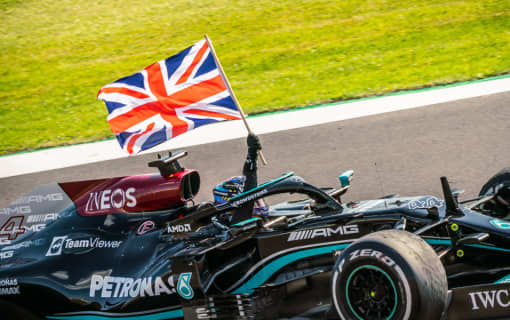It feels like there is always something going wrong! - Charles LeClerc
Ferrari. A name that will always be synonymous with automotive excellence. From road cars that changed our perception of style, to race cars that achieved the pinnacle of automotive engineering and innovation. From road to track, Ferrari changed the game and will forever be indelibly etched into the heritage of Formula 1 racing.
From the iconic ‘prancing horse’ logo to the flashy red colour, Ferrari are recognised as the zenith of motorsport, defined by quality, luxury, and an unmistakeable Italian racing pedigree. From the days of Alberto Ascari in the 1950’s to Niki Lauda in the 1970’s and the sheer dominance of Michael Schumacher in the 2000’s, the famous red race car enjoyed unparalleled success on the racetrack and helped create the most fanatical fanbase of any Formula 1 team – the Tifosi.
Now, two things Ferrari can always count on are fanatical support and high-powered financing. Having a tribe of loyal petrolheads follow your team around the world is not the kind of support all F1 teams can rely upon, but in the case of Ferrari, their international appeal means they are almost always the best supported team no matter which race. The Tifosi are raucous and unwavering in their support but demand the kind of success they have now not experienced for the best part of 20 years.
Having the financial gas in the tank to compete at the highest level has also been key to the success of Ferrari over the decades, spending over $450m in 2019 alone. In recent years however despite the support both financial and trackside, Ferrari has struggled to keep pace with the likes of Mercedes and Red Bull. After having last won a Drivers’ World Championship with Kimi Raikkonen in 2007 and their last Constructor’s World Championship title in 2008, it seemed for several reasons that 2022 might be the year fortunes changed for the famous team from Maranello.
Some big changes to Formula 1 rules came into effect for the 2022 season and with those changes to the rules, many commentators felt like this could be Ferrari’s chance to reinvent both their car and racing strategy. In summary, without wanting to delve into the minutiae of FIA (Federation Internationale de l’Automobile) regulations, here’s a quick summary of the three key changes that would potentially boost Ferrari’s chances in 2022:
- New tyres – this season all the F1 cars had a whole new look because of the new tyres. Pirelli replaced the old 13″ tyres with new 18″ tyres which provided more grip and less overheating so to encourage more overtaking.
- Budget cap – regulating the spending of all teams in theory gives each team more of an equal opportunity. Whilst Ferrari still had a sizeable budget, this change meant their primary competitors Mercedes and Red Bull were further constrained, bringing the teams closer together.
- Restrictions on aerodynamic testing – this change meant that the lower the team in the rankings, the more time it can spend testing in a wind tunnel. Given Ferrari’s relative lack of success in recent years, they could spend more time testing than their primary rivals ahead of the 2022 season.
In addition to the rule changes, Ferrari also made some key personnel alterations both on and off the racetrack. In January 2021, Laurent Mekies was appointed as Deputy Team Principal and Racing Director of Scuderia Ferrari and later that year, David Sanchez was promoted to Chief Engineer of Vehicle Concept leading the design and development of the 2022 Ferrari car. In a trio of strategically essential management changes, Fabio Montecchi was also promoted to chief project engineer in 2021.
This would also be the second year they could boast two of Formula 1’s best young talents as their drivers – in both Charles Leclerc and Carlos Sainz Jr., Ferrari have a pair of drivers that are talented enough to one day win a World Championship. After all, Leclerc came up through the karting ranks battling his arch-rival Max Verstappen from a young age and Sainz Jr. is the son of Carlos Sainz Sr., a two-time World Rally Champion, and four-time Dakar Rally winner. With both drivers seemingly destined for greatness, what actually happened throughout the 2022 season?
Ferrari made a fantastic start to the season – the battle of Bahrain ended with LeClerc first and Sainz Jr. second and in the second race of the year in Saudi Arabia, LeClerc and Sainz Jr. finished 2nd and 3rd respectively. Leclerc also claimed victory in a thrilling Australian Grand Prix. After the first three races, Leclerc was 46 points clear of Verstappen but as the 2022 season unfolded so did the chances of Ferrari winning another Drivers’ or Constructor’ World Championship.
With two races to go and Leclerc a staggering 141 points behind champion Verstappen in the points table – here are our main reasons into what happened to Ferrari in 2022 as we analyse the key races that impacted their season.
The problems for Ferrari in 2022 began with engine issues at the Spanish Grand Prix – despite starting from pole position, Leclerc who was the Driver’s Championship leader at the time and 46 points clear of Max Verstappen suffered a blown power unit and did not finish, scoring zero points.
The following week at the Monaco Grand Prix, Monégasque Leclerc again started the race on pole and was fastest all weekend, but due to a series of incomprehensible pit-stop strategy blunders, a dejected Leclerc finished his home race for the first time but ended the race outside the podium positions in an agonizing fourth place.
In what was a trio of terrible races for Ferrari, the Azerbaijan Grand Prix just two weeks later also ended in misery for Ferrari as another destroyed power unit ended Leclerc’s chances again. Heading into the race, he was only eight points behind Verstappen – that gap was up to 34 points after Verstappen’s win, which is notable because it was the first time the defending champion had a points advantage which exceeded a victory’s worth of points.
The impact was bigger than just the consequences for the race in Baku as it ensured Leclerc had to take a grid penalty for the next race in Canada. Just a week later at the Circuit Gilles Villeneuve in Montreal, Leclerc started 19th on the grid and despite coming through to fifth but his disadvantage was up to 49 points – near enough two wins’ worth of points.
As if these four races weren’t damaging enough to the chances of Ferrari, a very mixed British Grand Prix two weeks later would only further highlight problems with team strategy. Even though Carlos Sainz Jr. took both his first pole position and maiden Grand Prix victory, another pit-stop calamity and ineffective team orders cost Leclerc dearly.
At the French Grand Prix, Leclerc would again find himself on pole but this time it was not a technical issue or team incompetence but his own carelessness which ended his race. After leading the race into lap 18, Leclerc made an inexplicable error. With nobody ahead, Leclerc spun off the track, forcing him to retire which gifted the win to Verstappen.
With the writing now seemingly on the wall for Ferrari, two more hellacious races would follow. Another catastrophic strategy error which moved Leclerc into hard tyres despite the conflicting data caused much criticism amongst fans, with Leclerc himself branding the move a “disaster”.
In the final act that crashed Ferrari’s 2022 chances, the power deficit that existed between Ferrari and Red Bull was more than evident. At Spa, Belgium the FIA’s new directive on floor stiffness and so-called ‘vertical oscillations’ came into full force, and all F1 cars were further ride-height limited by the significant high-speed compression through ‘Eau Rouge.’ Despite starting on pole, Sainz Jr. finished almost 27 seconds behind Verstappen who started in 14th. Leclerc on the other hand was even further behind Verstappen, a colossal 70 seconds! This disparity not only demonstrated the lack of power in the Ferrari engine but also their inability to take care of their tyres.
After a season characterised by strategical ineptitude, driver error and technical deficiencies, it’s back to the drawing board for Ferrari. What’s for certain though is that Formula 1’s most iconic brand was on the cusp of success in 2022 – they will learn from their mistakes and will be back better and stronger in 2023.







